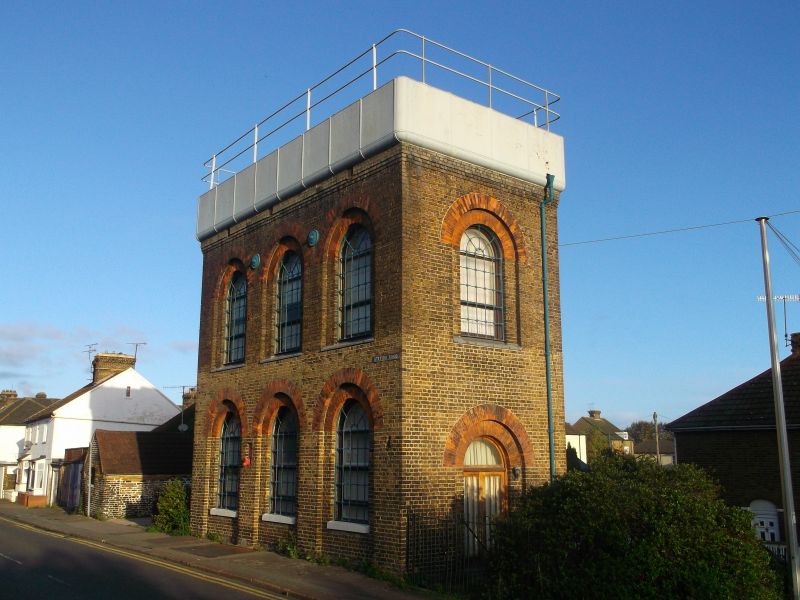Water towers
Posted
#258492
(In Topic #14121)
Full Member
How did they work?
Now, whenever we have a new member joins, we always say there is no such thing as a stupid question, but I might be pushing the limits of that claim recently. Anyway, here goes with another one.Here is the (converted) water tower at Faversham.

What was actually inside a water tower? Was it some sort of pumping mechanism? Did locos take their water from such a tower, or were these a sort of distribution hub to filling pumps on the platform? And where did the tower get its water? And was it stored in the metal tank on top of the tower, or is that something completely different? (I have an image of it collecting rain water in the hope of keeping a few thousand train journeys going. OK, maybe I'm not quite that daft, but I can come close!) On the wall between the far two windows is clearly an old connector tap. Would a hose have been attached to that to feed the loco?
The original railway line, or at least a siding, ran past the tower and the houses you can just make out around it, and the road, did not exist. But when the station was rebuilt and the track layout changed (Faversham became a junction) the line no longer ran to the water tower. However, this was still in the late 1800s, (1898 to be precise) so still steam…..
I await your wisdom, knowledge and insights.
Michael
 Last edit: by Headmaster
Last edit: by Headmaster
Posted
Full Member
The tower height provided both storage and pressure for distribuition. I wondered if the tank extended down behind the top row of window with some form of pumping mechanism on the ground floor.
The water could be distribuited either direct from a crane attached to the tower or through a network of cranes installed around the station/yard.
I believe the original supply of water varied….Railway Company, Town Corporation etc……On some rural branches it was from a local spring and the local branch loco would be used to pump it up and fill the much more utilitarian tank
You have such nice buildings in Feversham
Posted
Full Member
I'd always taken the yard tank to be just another variant of header tank, still found in homes today. For tender filling the flow rate requirements would no doubt have exceeded the mains ability to deliver in those days or because of lack of suitable nearby high volume supply..
Presumably the simple platform syphon was connected to some header tank elsewhere in the precinct.
Posted
Full Member
Michael
Posted
Full Member
Michael
Posted
Full Member
Michael
Posted
Full Member
Cheers Pete.
Posted
Full Member
Google maps clearly shows that the tower is enclosed at the top but whether that was how it was or it was enclosed as part of the conversion to a house, who knows.
Here is an extract from Wikipedia,
Railway Water Tower. C1858 for the London, Chatham and Dover Railway, probably by
their engineer Crampton. Classical style rectangular structure of 2 storeys, 3 windows
built of stock brick with red dressings, riveted iron water tank above and iron framed
windows. Road elevation has 1st floor blank round-headed openings in arcading and
3 ground floor round headed openings with fixed iron glazing, all with rubbed red
brick arches. Rear elevation similar but entirely of blank arcading. Left side
round headed doorcase with fanlight and blank above. Moulded brick eaves cornice.
Above is riveted iron water tank reached by fixed iron ladder. Included for rarity
of survival of railway water towers.
You may be welcomed by the current owners if you pay a visit and they may be able to supply you with more information.
Good luck with endeavours to create a model.
Gary
__________________________________________________
I am no expert but I do what I can, when I can, with what I can.
__________________________________________________
I am no expert but I do what I can, when I can, with what I can.
Posted
Site staff

Aparently they have an inlet pipe, an outlet pipe, and overflow. . The one at Mill Yard stabled the station Horse underneath, The one at Settle was a girt big un and stabled Several horses underneath, and some had a chimney ( for heating to stop them freezing ?)
Enough already I got work to do !
Cheers (An easily distracted)
Matt
Wasnie me, a big boy did it and ran away
"Why did you volunteer ? I didn't Sir, the other three stepped backwards"
"Why did you volunteer ? I didn't Sir, the other three stepped backwards"
Posted
Full Member
Poetry in motion :cheers
Well done YMRC,
Bill
 Last edit: by Longchap
Last edit: by Longchap
At 6'4'', Bill is a tall chap, then again, when horizontal he is rather long and people often used to trip over him! . . . and so a nickname was born :)
Posted
Full Member
Michael
Posted
Full Member
I presume your tower works on exactly the same principle Michael. If you connect a large enough pipe to a large enough hole in the tank, one could fill a loco tender in a few minutes. No mains supply could provide that volume in such a short time.
'Petermac
Posted
Full Member
Michael
Posted
Full Member
There's a very famous conversion of a domestic supply water tower in Dalkieth which is now apparently, a restaurant.
Google "Dalkieth water tower" and have a look - it's very impressive.
'Petermac
Posted
Full Member
Kennington water tower - Grand Designs Magazine : Grand Designs Magazine
They can make spectacular homes and with interesting views, but I'd rather do a conversion from a country station building to get a fuller railway ambience, hopefully with the platform and stationmaster's garden.
The current Faversham tower owners get a gold star for letting you take a glimpse inside Michael.
Right, back to topic and enjoy the continuing research voyage of discovery.
Best,
Bill
At 6'4'', Bill is a tall chap, then again, when horizontal he is rather long and people often used to trip over him! . . . and so a nickname was born :)
Posted
Full Member
Wallingford was one , the pump being in a little hut just inboard of the platform.
This supposed that the water was fit to use without treatment, which wasn't always the case.
Come to think of it,I don't recall seeing a water treatment plant modelled.
At the SDR we are fortunate as all that is needed is a cupfull of tannic acid powder in a tank full.
Doug
 Last edit: by Chubber
Last edit: by Chubber
'You may share the labours of the great, but you will not share the spoil…' Aesop's Fables
"Beer is proof that God loves us and wants us to be happy" - Benjamin Franklin
In the land of the slap-dash and implausible, mediocrity is king
"Beer is proof that God loves us and wants us to be happy" - Benjamin Franklin
In the land of the slap-dash and implausible, mediocrity is king
Posted
Full Member
The Taunton Model Railway Group included a model of the Water Treatment/Softening Plant at Bath Green Park:-….
Come to think of it,I don't recall seeing a water treatment plant modelled.
At the SDR we are fortunate as all that is needed is a cupfull of tannic acid powder in a tank full.
Doug

complete with sludge tender.
 Last edit: by Alan W
Last edit: by Alan W
Alan
1 guest and 0 members have just viewed this.

